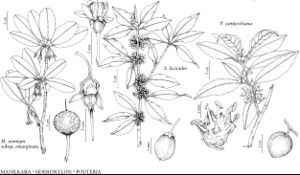Shrubs or trees, deciduous or evergreen, sap milky. Leaves alternate or whorled (fascicled) on short shoots, simple; stipules present or absent; petiole with decurrent, adaxial wing forming channel or groove; blade margins entire; venation pinnate. Inflorescences axillary, fasciculate or solitary flowers at leafy or defoliated nodes on older growth. Flowers bisexual [unisexual]; perianth and androecium hypogynous; sepals [2–]4–8[–11], distinct; petals 4–8[–9], connate proximally, lobes not divided or divided into 1 median and 2 lateral [abaxial] segments, corolla rotate, cyathiform, or tubular; nectary disc present; stamens 4–8[–12], antipetalous, epipetalous; anthers dehiscent by longitudinal slits; pistils 1, [1–]3–12[–30]-carpellate; ovary superior, [1–]3–12[–15]-locular; placentation axile, basal, or basiventral; ovules anatropous or hemitropous, unitegmic, tenuinucellate; styles 1, terminal, exserted or included; stigmas 1, capitate or slightly lobed. Fruits baccate [capsular]. Seeds 1–10, brown to black, shiny, indurate; hilum prominent; embryo vertical, oblique, or horizontal; endosperm oily or absent.
Distribution
North America, Mexico, West Indies, Central America, South America, Asia, Africa, Atlantic Islands, Indian Ocean Islands, Pacific Islands, Australia.
Discussion
Genera 53, species ca. 1100 (5 genera, 16 species in the flora).
The monophyly of the Sapotaceae (including Sarcosperma) is supported by molecular phylogenetic studies (A. A. Anderberg and U. Swenson 2003; Swenson and Anderberg 2005). Three subfamilies were proposed by Swenson and Anderberg in contrast to the five tribes recognized by T. D. Pennington (1991, 2004, 2004b) and R. Govaerts et al. (2001). The Sapotaceae are characterized by the presence of latex, malpighian hairs, fasciculate inflorescences, and antipetalous stamens. The family is widespread throughout the tropics and has economically important species. Manilkara zapota provides chicle for chewing gum, and some species provide edible fruits, e.g., Chrysophyllum cainito (star-apple), Pouteria mammosa (mamey), and P. campechiana (canistel or egg-fruit). Mature fruits of our species of Sideroxylon are edible, and have not been exploited economically. Chrysophyllum oliviforme and Mimusops elengi are handsome trees and often planted as ornamentals.
Selected References
Lower Taxa
Illustrations
Key
| 1 | Sepals 6 or 8 in 2 whorls, outer valvate | > 2 |
| 1 | Sepals 4-6 in 1 whorl, imbricate | > 3 |
| 2 | Sepals 8 in 2 whorls of 4; hilum circular. | Mimusops |
| 2 | Sepals 6 in 2 whorls of 3; hilum linear. | Manilkara |
| 3 | Corolla lobes divided; stems not armed or armed with thorns; seeds 4-12 mm. | Sideroxylon |
| 3 | Corolla lobes undivided; stems unarmed; seeds 13-40 mm | > 4 |
| 4 | Petioles 5-10 mm; leaves densely hairy abaxially; staminodes absent. | Chrysophyllum |
| 4 | Petioles 10-51 mm; leaves glabrous or glabrate abaxially; staminodes petaloid | > 5 |
| 5 | Pedicels glabrous; sepals 1.5-2 mm; berries yellow to orange. | Sideroxylon |
| 5 | Pedicels densely hairy; sepals 4.5-11 mm; berries brown | Pouteria |


